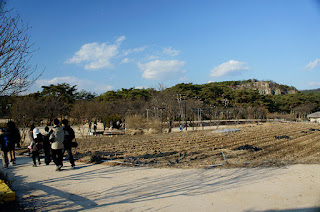 Andong is a city in Gyeongsangbuk-do Province, South Korea. It is the largest city in the northern part of the province with a population of 167,821 in October 2010.
Andong is a city in Gyeongsangbuk-do Province, South Korea. It is the largest city in the northern part of the province with a population of 167,821 in October 2010.
The Nakdong River flows through the city. Andong is a market centre for the surrounding agricultural areas.
Andong is known as a centre of culture and folk traditions.
The surrounding area maintains many ancient traditions, so in mid October the Andong Folk Festival is held every year.
One of the most famous aspects of these cultural festivities are the Andong masks.
Today, I am going to visit Andong city with one-day tour program.
There is a bus which take me to the famous place ~
I didn't have to worry about time and transportation ...
It was very simple and easy trip.
There are two different courses that one is Dosan seowon, another one is Hahoe village course. I took a Hahoe village course. This is the bus I took all day.
 On the way to Buyoungdae.
Buyoungsae cliff ; you can overlook Hahoe village and Nakdong river.
It takes about 5 minutes to get cliff walk along the woods.
This is th view form the Buyoungdae cliff.
It is very clear and fresh today.
On the way to Buyoungdae.
Buyoungsae cliff ; you can overlook Hahoe village and Nakdong river.
It takes about 5 minutes to get cliff walk along the woods.
This is th view form the Buyoungdae cliff.
It is very clear and fresh today.
.

A couple is walking on the Nakdong-river. Beautiful.~~
Nice pine tree.
A tour guide said this tree is more than 400 years old.. Wow~
 After Buyoungdae cliff ,we head for Byeongsan seowon.
After Buyoungdae cliff ,we head for Byeongsan seowon.
Like most institutions, Byeongsan Seowon was established by local scholars and supported by sympathetic members of the local community.
The Seowon was largely autonomous from the government and around the time of 1863, Confucian schools enjoyed many freedoms under the Joseon rule, students and scholars of the school were free from taxation, conscription, labor duties and other expenses.
Initiated the tradition at private academies of enshrining departed Confucian scholars whose lives were worthy of emulation. Someon told me that Korea does not have garden culture. It's from Japan I have heard. Tara~ Lunch time~
This is the famous Andong mackerel with seasoning source.
Fish was so delicious!! With this seasoning source makes the taste better.
Tara~ Lunch time~
This is the famous Andong mackerel with seasoning source.
Fish was so delicious!! With this seasoning source makes the taste better.
It was 18,000 won for 2 people.
Well baked fish~.Yum yum~
This is the bus from the ticket box to enterance of Hahoe village.
We had to change the bus. Our city tour bus could not get in front of village.
 Andong Hahoe Village has preserved the housing architecture and the village structure of the Joseon Dynasty. Moreover, the village was not artificially created; there are people who actually live there.
Andong Hahoe Village has preserved the housing architecture and the village structure of the Joseon Dynasty. Moreover, the village was not artificially created; there are people who actually live there.
These are Korean traditional totem pole at the village entrance.  The village was very quite.
The village was very quite. 
The area is a well-preserved example of a typical clan village from the Joseon Dynasty days. But what’s unusual about Hahoe is how the aristocratic yangban class and commoners lived together. The largest homes are located at the center of the village, which is divided by a road stretching northeast and southwest. Thers is a name Bukchon-da다 that has 72 rooms and you can stay if you want.
Thers is a name Bukchon-da다 that has 72 rooms and you can stay if you want.
It is Korean.http://www.bukchondaek.com/

This zelkova tree is more than 600 years.. the guide told me.
This tree is also using when village people hold a memorial service for theirs ancestors. There is a wish fence around a tree.
There is a wish fence around a tree.
People was writing theirs wishes and hang in there. Here, people make this gate as follow geomancy.
When I stand the middle of the door, I can see the highest of mountain.
Yangjin-dang, the representative house of Yangban (the upper class of old Korea)
This Yangjin-dang shows the mix style building of Koryo dynasty and Chosun dynasty.
It is also designated a treasure No.306.

This is a memorial tree when the queen of England visited here a long time ago.
If it is summer , it would have been great. Actually that day was a little cold.
I could know people actually are living here when I saw this a small field. Super chubby cat~ A guide said this cats are eatting Andong markerel every day.
Super chubby cat~ A guide said this cats are eatting Andong markerel every day. 
Going for Hanji (traditional Korean paper handmade from mulberry trees) factory. 
He is the order of this factory~ and inside look. 
This process is how they are making Hanji.Wow.. this is not a simply work and it is going to be a good educate for a kids. There are beautiful papers from handmade works.You can join to the experience of dyeing when you pay 2,000 won.Hanji factory was the last tour place of the day trip.
There are beautiful papers from handmade works.You can join to the experience of dyeing when you pay 2,000 won.Hanji factory was the last tour place of the day trip.





















































































